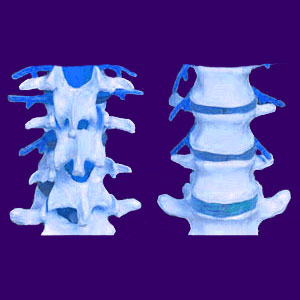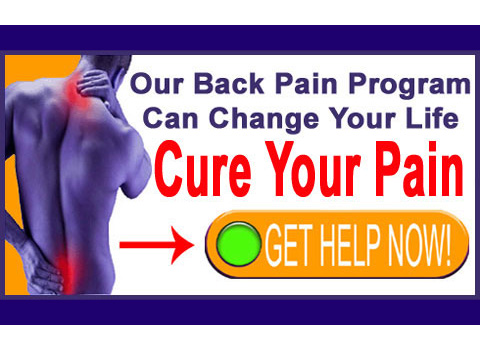
Mechanical back pain is a general term for dorsopathy concerns which are caused by a structural back injury, degenerative back pain condition or idiopathic source in the spinal column or back muscle anatomy. This condition is also commonly referred to as structural back pain, physically-induced back pain or anatomically-motivated back pain. However, the best definition of mechanical pain describes symptoms that are produced when one spinal structure moves against another, such as the typical motion within the spinal joints.
This essay investigates various types of mechanical joint pain conditions that can affect the vertebral column.
Mechanical Pain Conditions
There are seemingly endless diagnoses used to explain structural symptoms within the back pain industry. Every single spinal structure has been targeted as a potential source of lasting and acute misery in some patients.
Modern medicine follows a Cartesian philosophy, which embraces finding an anatomical reason for every single painful complaint. To this end, the healthcare system has succeeded 100%. Unfortunately, although doctors and chiropractors have identified a plethora of possibly symptomatic structures in the spine and surrounding soft tissues, back pain patients still rarely find relief for their chronic pain. The reason for this is remarkably simple. Many of these diagnoses implicating the spinal structures as the source of chronic back pain are mostly unenlightened, incorrect and a travesty of medical science.
This statement is supported by countless research studies which demonstrate little correlation between structural abnormalities and the incidence of back ache, as well as newly revised guidelines for diagnosis offered by many major medical associations warning doctors not to assume anatomical irregularities are the source of symptoms without definitive proof.
Mechanical Back Pain Concerns
The most commonly diagnosed sources of structural back pain are the intervertebral discs. Completely normal parts of the spinal aging process, such as degenerative disc disease and even herniated discs are the most prevalent issues which carry the blame for many painful conditions. The vertebrae are not immune either, with facet joint syndrome and arthritis in the spine taking in a fair share of the diagnostic pronouncements.
Of course, neurological concerns are always a big part of back pain diagnosis, with foraminal stenosis, spinal stenosis, pinched nerves and other radiculopathy problems, like sciatica, doing their fair share.
Back muscle pain is a very common diagnosis as well, and the related severe pain syndromes, such as fibromyalgia and thoracic outlet syndrome are on the rise in medical diagnosis every day.
This is only the tip of the iceberg when it comes to back pain diagnosis, with many other conditions making up the pool of guilty anatomical defects. Spondylolisthesis, scoliosis, kyphosis, lordosis, sacroiliac pain and piriformis syndrome all make token showings in the back pain scene. Renee Descartes would be proud indeed!
Mechanical Back Pain Facts
Acute back pain due to an injury may be obviously physically-induced. Some serious degenerative processes may also be capable of producing mild to moderate anatomically induced symptoms. However, the body is designed to heal and heal it will, in almost every case. Given proper medical care, most structural back pain conditions should resolve. However, this rarely occurs.
Statistics reveal that people who suffer back pain for more than 6 – 12 months have a better chance of suffering for life than they do of ever recovering completely. This is very scary indeed!
One reason why medical science has been impotent in the face of the back pain epidemic is the obvious flaws in the diagnostic process. The facts clearly show that mechanical back pain is rarely the source of chronic symptoms.
Meanwhile, the incidence of psychosomatic back pain enacting a long-term battle with ischemia as its enforcer is rarely even brought up as a possibility for patients with unresponsive pain. As previously mentioned, the Cartesian philosophy of most doctors prevents them from even acknowledging the possibility that some ongoing back ache syndromes (or any chronic pain conditions, regardless of where in the body they occur) could be the direct result of the constant interactions between the mind and the body.
If your structurally diagnosed back pain has not healed, despite the best efforts of your doctors, you might consider that your diagnosis may be flawed. Many of the structural concerns blamed for causing symptoms are nothing more than back pain scapegoats. They might be atypical in the spinal anatomy, but this does not make them inherently symptomatic. They may have simply been blamed since there is no other logical answer as to why you are in misery, unless of course you take into consideration the overwhelming incidence of emotional stress back pain concerns.
It seems that accepting this possibility is just too logical for the back pain industry to comprehend. They would rather blame the anatomy for pain, despite the overwhelming evidence of the contrary. Of course, this scenario does not apply to all cases, but is food for thought for patients who fit the profile and are interested in really understanding why they possibly can not find a cure, despite their desire and best efforts.





